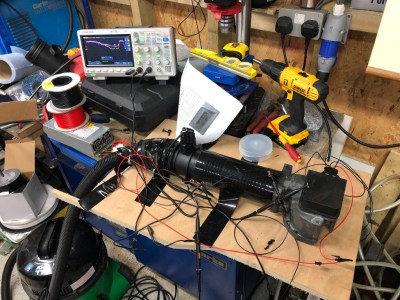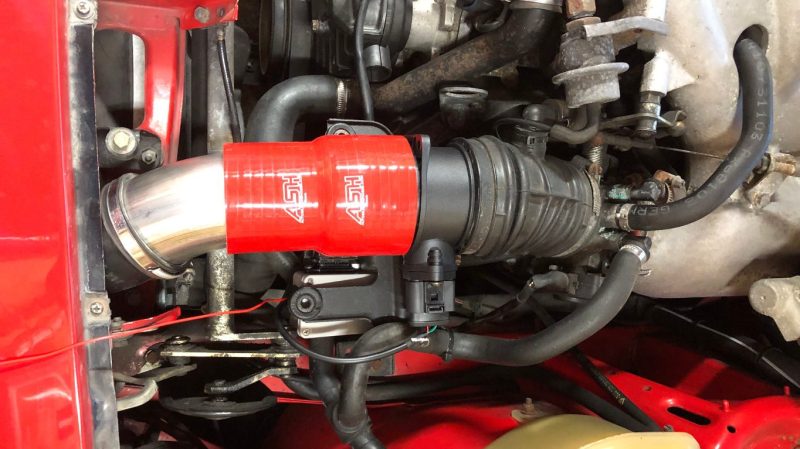Electronic fuel injection was a big leap forward for engine control. However, early implementations often left something to be desired. This was the case for [Rob] and his Porsche 944, which had relied on an old-fashioned mechanical air flow meter (AFM). He decided to replace this with a modern mass air flow (MAF) sensor instead, and documented the process online.

AFMs are often a target for replacement on old cars. They’re usually based on a flap that moves a potentiometer wiper across a carbon trace which wears out over the years. They can also present an air flow restriction in some cases, limiting performance. MAF sensors instead measure the amount of air flowing through with a hot wire. The amount of current required to maintain the temperature of the wire indicates the amount of air flowing through the sensor. They’re less restrictive and readily available as they’re used in many cars today.
To run a MAF in place of the AFM requires a circuit to emulate the AFM’s output. [Rob] used a STM32 Cortex-M0 to read the MAF, and then output the relevant voltage to the Porsche’s engine computer via PWM and a low pass filter. To figure out how to map the MAF’s output to match the AFM, [Rob] built a rig to blow air through both devices in series, and measuring their output on an oscilloscope. This data was used to program the STM32 to output the right emulated AFM voltage for the given MAF signal.
It’s a great piece of work from [Rob] that has his Porsche running happily on new parts. We’ve seen similar hacks done to other cars before, as well! Video after the break.
















I’m one to complain about long videos on HaD, but 7 seconds?
Couldda been a gif honestly ngl.
It probably doesn’t matter thaaat much, but if it was my vintage engine I’d be concerned about the algorithms in the ECU that compensate for intake temperature. An AFM measures volume and a maf measures mass. Depending on how stringent the ECU is programmed it will try to approximate the mass of the intake charge based on volume and temperature. This can run the risk of changing the AFR depending on temperature.
I had a BMW 325i from this vintage.
The compensation is the least of your issues.
The original flap has a contact potentiometer and a spring. The spring wears out and potentiometer wears. They are long out of stock. Mine would start oscillating at low engine speed and never got it fixed. The refurbished flap sensor was more than twice what I paid for the car.
I question the point of measuring the old worn out one to adapt the mass air sensor though.
If you still have it, there’s an easy fix. The cause of the problem is that the metal wiper digs grooves into a relatively wide stripe of resistive material. Re-positioning the wiper and bending it slightly to contact on an undamaged region makes it work like new again.
That’s a hack!
Thanks for posting!
I did move the wipers. The spring fatigued and it is near impossible to get it to the proper resistance again.
There have been drop in MAF conversion kits for the 944 since at least 2009, though most also come with a new eeprom for the DME (Bosch speak for ECU) to take full advantage of the superior flow characteristics of the less restrictive intake. Still, there have been enough plug and play setups that if this were an issue someone would definitely have noticed by now.
The O2 sensor feedback will compensate for the Mixture difference because of the Volume VS Mass Issues..
However the VE Calculations will be off, so the Engine Ignition Table will be wrong.. But how much is anybody’s guess..
If you are able to get to the ‘Fuel Trims’ in the ECU, and adjust your MAF output to keep the trims close to Zero, then your close enough..
It’s trivial to burn a new eeprom for the ECU on these cars. That’s why most of the mass produced MAF kits come with a new chip.
O2 sensor on these cars is narrowband and of course only used in closed loop. My experience with other makes of the same vintage suggests that’s basically only used at cruise, idle and >50% throttle are open loop based on the AFM with integrated temp sensor and RPM.
I had a Jetta VW with a golf GTI engine in it and for one or two years they used the mechanical flow. This engine is still run in Rally and for collectors… There is just no replacement available. My Jetta was left to rot. I don’t even know how it ended.
Came to cry about how I couldn’t do this in California, but a 1989 model year is over 25yrs old, meaning it is smog exempt so you can modify intake stuff all you want. Great hack.
Anything 1975 and newer still requires a smog in California.
Will they even notice? If you do it properly they might not. Also they use a 5gas analyzer to check the tailpipe emissions.
I smogged my VR6 and the paperwork said 4cyl on it. :shrug:
True story. I was very glad my 1976 was registered in VA, a state with permanent Classic Car registration and in accordance with the Service Member’s Civil Relief Act (SCRA), I was not required to change my registration until my current one expires….which VA’s never did.
My car is over 30 years old and still requires smog. Unless something changed recently California requires smog for all gas car made after 1975. If you could make it look stock enough you might get it passed CA smog. But judging from the wall sockets this hack was done in the UK (maybe?).
Calif. requires any and all cars after 1967 to have all the factory installed emission controls, it may even go back to 1964, I’m not exactly sure since it’s has over 30 years since I left Calif… I do remember being there during the 80’s with my car from 1970 which was not a Calif. emission equipped car and later on having real issues getting it registered. Later on, I had a 1972 of the same make and model which I was able to get registered but only after having to have it written off due to the costs of getting it to pass the strict requirements at that time. Back then a vehicle had to be able to make a 10% improvement and keep the costs under a set limit for vehicles over a specific age. As far as going to the trouble of equipping an older vehicle with EFI, I fail to see why anyone would go to all this effort since there are aftermarket companies that make systems for converting old vehicles to this. DIY Autotune is one of several. Now I’m not sure about getting them to pass an emissions test out there but if the vehicle can be set up with an EFI system that has all or even some of the features a later model system would offer, exhaust output made above quality of what OEM fuel systems produced, it seems the state would approve or should approve. They are really anal out there about any internal combustion powered transportation anymore. There are some manufacturers that have been able to get their products CARB certified and in those cases, cert. #’s are issued and if any modifications are done to a car and they can carry that cert # to the emissions test facility, the DMV has to issue registration for the vehicle. That’s the way it was back then anyhow. I have read some about how things advanced up to some years ago with aftermarket equipment and it was this way for a long time.
There was a dude on the net putting the motor from a Chrysler LS series into a VW bus, thought it would be cake to get a pass going from nasty early 70s carbs to late 90s injection motor with all the emission equipment in place, ha ha, nope.
You take it to a referee who verifies all the smog equipment is indeed functional. Then you get a plaque in your engine bay stating it has been re-engined with the engine you have now. It is doable.
There is actually already an exemption for 80s VW vans with a specific Subaru motor. A company went through the process and got a C.A.R.B. (CA Air Resources Board) exemption anyone can use.
Technically they require all smog equipment installed. In practice once the rolling 25 years hit 1975 it stopped and they don’t test 75 and older.
” They are really anal out there about any internal combustion powered transportation anymore. ”
They are really anal out there
FTFY
B^)
Very clever and handy
In order to do this properly he needs temperature compensation too. If the air temp changes from what temp he calibrated at, the MAF reading will change whereas the AFM reading wouldn’t.
AFM measures flow, MAF measures mass by measuring how much a hot wire cools down. Colder air at the same flow = more air mass.
If only the air being colder would also cool the hotwire down.
All the AFMs I’ve opened have had IAT sensors in them too. As, I believe have most COTS MAFs, built in.
Interesting project. I took a different path with my ’87 944S, also with the intention of replacing the AFM.
Replaced the entire ECU with a Megasquirt. That led to several changes in the sensors. The old O2 sensor was only able to provide binary output, so I connected a new Bosch Lambda sensor to a wideband O2 controller. Now I can dial it in to 14.7 for best emissions and fuel efficiency.
The AFM came off, as the Megasquirt provides a Bar sensor tube. Teed it into the vacuum, then welded a bung to a piece of pipe. A GM intake temperature sensor screws in and connects to the old harness. The lack of AFM intake restriction led to adjusting the screw on the intake as idle was too high. This change eliminated low RPM lag, caused by the barn door AFM.
Finally, I have been using Tuner Studio Pro to tweak the air-fuel ratio settings at all RPMs and the idle air control valve at all engine temperatures to get the engine running perfectly. I could not be happier with the transformation.
Is there possibility to use prebuild pcb like ordiuno or something else?
Is it possible to use prebuild pcb like Arduino or other?